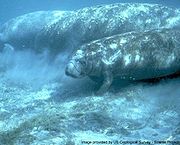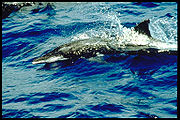
List of mammals in the Turks and Caicos Islands
Encyclopedia
This is a list of the mammal species recorded in the Turks and Caicos Islands. There are 4 mammal species in the Turks and Caicos Islands
, of which 0 are critically endangered, 0 are endangered, 1 is vulnerable, and 0 are near-threatened.
The following tags are used to highlight each species' conservation status as assessed by the IUCN
:
Some species were assessed using an earlier set of criteria. Species assessed using this system have the following instead of Near Threatened and Least Concern categories:
Order: Sirenia
----
 Sirenia is an order of fully aquatic, herbivorous mammals that inhabit rivers, estuaries, coastal marine waters, swamps, and marine wetlands. All four species are endangered.
Sirenia is an order of fully aquatic, herbivorous mammals that inhabit rivers, estuaries, coastal marine waters, swamps, and marine wetlands. All four species are endangered.
The bats' most distinguishing feature is that their forelimbs are developed as wings, making them the only mammals in the world naturally capable of flight. Bat species account for about 20% of all mammals.
Order: Cetacea
----
 The order Cetacea includes whale
The order Cetacea includes whale
s, dolphin
s and porpoise
s. They are the mammals most fully adapted to aquatic
life with a spindle-shaped nearly hairless body, protected by a thick layer of blubber, and forelimbs and tail modified to provide propulsion underwater.
Turks and Caicos Islands
The Turks and Caicos Islands are a British Overseas Territory and overseas territory of the European Union consisting of two groups of tropical islands in the Caribbean, the larger Caicos Islands and the smaller Turks Islands, known for tourism and as an offshore financial centre.The Turks and...
, of which 0 are critically endangered, 0 are endangered, 1 is vulnerable, and 0 are near-threatened.
The following tags are used to highlight each species' conservation status as assessed by the IUCN
World Conservation Union
The International Union for Conservation of Nature and Natural Resources is an international organization dedicated to finding "pragmatic solutions to our most pressing environment and development challenges." The organization publishes the IUCN Red List, compiling information from a network of...
:
| EX | Extinct | No reasonable doubt that the last individual has died. |
| EW | Extinct in the wild | Known only to survive in captivity or as a naturalized populations well outside its previous range. |
| CR | Critically Endangered | The species is in imminent risk of extinction in the wild. |
| EN | Endangered | The species is facing an extremely high risk of extinction in the wild. |
| VU | Vulnerable | The species is facing a high risk of extinction in the wild. |
| NT | Near Threatened | The species does not meet any of the criteria that would categorise it as risking extinction but it is likely to do so in the future. |
| LC | Least Concern | There are no current identifiable risks to the species. |
| DD | Data Deficient | There is inadequate information to make an assessment of the risks to this species. |
Some species were assessed using an earlier set of criteria. Species assessed using this system have the following instead of Near Threatened and Least Concern categories:
| LR/cd | Lower Risk/conservation dependent | Species which were the focus of conservation programmes and may have moved into a higher risk category if that programme was discontinued. |
| LR/nt | Lower Risk/near threatened | Species which are close to being classified as Vulnerable but are not the subject of conservation programmes. |
| LR/lc | Lower Risk/least concern | Species for which there are no identifiable risks. |
Order: SireniaSireniaSirenia is an order of fully aquatic, herbivorous mammals that inhabit swamps, rivers, estuaries, marine wetlands, and coastal marine waters. Four species are living, in two families and genera. These are the dugong and manatees...
(manatees and dugongs)
----
- Family: Trichechidae
-
- Genus: Trichechus
- West Indian ManateeWest Indian ManateeThe West Indian Manatee is a manatee, and the largest surviving member of the aquatic mammal order Sirenia . The West Indian Manatee, Trichechus manatus, is a species distinct from the Amazonian Manatee, T. inunguis, and the West African Manatee, T. senegalensis...
Trichechus manatus VU
- West Indian Manatee
- Genus: Trichechus
-
Order: Chiroptera (bats)
----The bats' most distinguishing feature is that their forelimbs are developed as wings, making them the only mammals in the world naturally capable of flight. Bat species account for about 20% of all mammals.
- Family: Molossidae
-
- Genus: TadaridaTadaridaThe genus Tadarida has ten or more species of bats divided into two subgenera, with the first of these containing seven species spread across the Old World...
- Mexican Free-tailed BatMexican Free-tailed BatThe Mexican free-tailed bat , also known as the Brazilian free-tailed bat, is a medium-sized bat that is native to the Americas and is widely regarded as one of the most abundant mammals in North America...
Tadarida brasiliensis LR/nt
- Mexican Free-tailed Bat
- Genus: Tadarida
-
- Family: Phyllostomidae
- Subfamily: Brachyphyllinae
- Genus: BrachyphyllaBrachyphyllaBrachyphylla is a genus of bat in the family Phyllostomidae.It contains the following species:* Cuban Fruit-eating Bat * Antillean Fruit-eating Bat...
- Cuban Fruit-eating BatCuban Fruit-eating BatThe Cuban Fruit-eating Bat is a species of bat in the family Phyllostomidae. It is found in Bahamas, Cayman Islands, Cuba, the Dominican Republic, Haiti, Jamaica, and Turks and Caicos Islands.-Source:...
Brachyphylla nana LR/nt
- Cuban Fruit-eating Bat
- Genus: Brachyphylla
- Subfamily: Brachyphyllinae
Order: CetaceaCetaceaThe order Cetacea includes the marine mammals commonly known as whales, dolphins, and porpoises. Cetus is Latin and is used in biological names to mean "whale"; its original meaning, "large sea animal", was more general. It comes from Ancient Greek , meaning "whale" or "any huge fish or sea...
(whales)
----
Whale
Whale is the common name for various marine mammals of the order Cetacea. The term whale sometimes refers to all cetaceans, but more often it excludes dolphins and porpoises, which belong to suborder Odontoceti . This suborder also includes the sperm whale, killer whale, pilot whale, and beluga...
s, dolphin
Dolphin
Dolphins are marine mammals that are closely related to whales and porpoises. There are almost forty species of dolphin in 17 genera. They vary in size from and , up to and . They are found worldwide, mostly in the shallower seas of the continental shelves, and are carnivores, mostly eating...
s and porpoise
Porpoise
Porpoises are small cetaceans of the family Phocoenidae; they are related to whales and dolphins. They are distinct from dolphins, although the word "porpoise" has been used to refer to any small dolphin, especially by sailors and fishermen...
s. They are the mammals most fully adapted to aquatic
Aquatic adaptation
Several animal groups have undergone aquatic adaptation, going from being purely terrestrial animals to living at least part of the time in water. The adaptations in early speciation tend to develop as the animal ventures into water in order to find available food. As successive generations spend...
life with a spindle-shaped nearly hairless body, protected by a thick layer of blubber, and forelimbs and tail modified to provide propulsion underwater.
- Suborder: Odontoceti
- Superfamily: Platanistoidea
- Family: Delphinidae (marine dolphins)
- Genus: Steno
- Rough-toothed DolphinRough-toothed DolphinThe Rough-toothed dolphin is species of dolphin that can be found in deep warm and tropical waters around the world.The species was first described by Georges Cuvier in 1823...
Steno bredanensis DD
- Rough-toothed Dolphin
- Genus: Steno
- Family: Delphinidae (marine dolphins)
- Superfamily: Platanistoidea
See also
- List of chordate orders
- List of regional mammals lists
- List of prehistoric mammals
- Mammal classificationMammal classificationMammalia is a class of animal within the Phylum Chordata. Mammal classification has been through several iterations since Carolus Linnaeus initially defined the class. Many earlier ideas have been completely abandoned by modern taxonomists, among these are the idea that bats are related to birds...
- New mammal species

